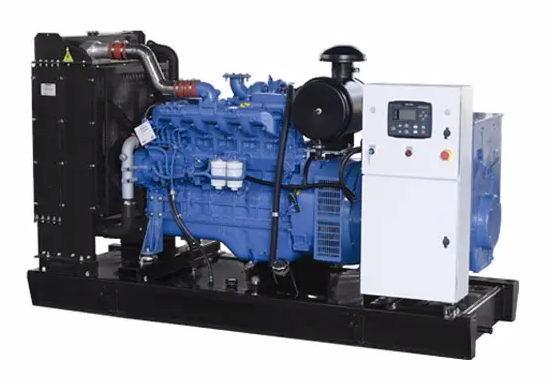dingbo@dieselgeneratortech.com
+86 134 8102 4441

- Home
- Products
- About Us
- Service
- News
- Technical Support
- Contact Us
dingbo@dieselgeneratortech.com
+86 134 8102 4441
May. 13, 2022
Mechanical failure of diesel engine during operation may cause damage to basic parts or major mechanical accidents. Usually, before the failure of diesel engine, its speed, sound, exhaust, water temperature, oil pressure and other aspects will show some abnormal signs, that is, the characteristics of fault omen. Therefore, operators should quickly make correct judgment according to the characteristics of omen and take decisive measures to avoid accidents.
1. Warning characteristics of overspeed fault
Before overspeed, the diesel engine will generally emit blue smoke, burn engine oil or unstable speed.
Treatment measures: first, close the throttle and stop oil supply; Second, block the intake pipe and cut off the entry of air; Third, quickly loosen the high-pressure oil pipe and stop oil supply.
2. Precursory characteristics of sticking cylinder fault
Cylinder sticking generally occurs when the diesel engine is seriously short of water. Before cylinder sticking, the engine runs weakly, and the water temperature gauge indicates more than 100 ℃. Drop a few drops of cold water on the engine body, with hissing sound, white smoke and water droplets evaporating quickly.
Treatment measures: idle for a period of time or turn off the engine and crank the crankshaft to help cool, reduce the water temperature to about 40 ℃, and then slowly add cooling water. Be careful not to add cooling water immediately, otherwise the parts will be deformed or cracked due to the sudden and rapid drop of local temperature.

3. Precursory characteristics of tamping cylinder failure
The cylinder tamping is a destructive mechanical failure. Except for the cylinder tamping caused by the valve falling, it is mostly caused by the loosening of the connecting rod bolt. After the connecting rod bolt is loosened or stretched, the matching clearance of the connecting rod bearing increases. At this time, the knocking sound can be heard at the crankcase, and the knocking sound changes from small to large. Finally, the connecting rod bolt completely falls off or breaks, and the connecting rod and bearing cap throw out, breaking the body and relevant parts.
Maintenance measures: stop the machine and replace the new parts immediately.
4. Precursory tile fault characteristics
When the diesel engine is working, the speed suddenly decreases, the load increases, the engine emits black smoke, the oil pressure decreases, and the dry friction sound of chirping occurs in the crankcase.
Treatment measures: stop the machine immediately, remove the cover, check the connecting rod bearing bush, find out the cause, repair and replace.
5. Precursory characteristics of shaft failure
When the diesel engine crankshaft journal shoulder produces a hidden crack due to fatigue, the fault symptom is not obvious. With the expansion and aggravation of the crack, a dull knocking sound occurs in the engine crankcase. When the speed changes, the knocking sound increases, and the engine emits black smoke. Soon, the knocking sound gradually increases, the engine shakes, the crankshaft breaks, and then stalls.
Treatment measures: shut down the machine for inspection immediately in case of any omen, and replace the crankshaft in time in case of cracks.
6. Precursory characteristics of cylinder pulling fault
The exhaust pipe emits serious black smoke and suddenly stalls, and the crankshaft cannot rotate. At this time, the diesel engine cannot be started for operation, but the cause should be found out and eliminated.
Treatment measures:
(1) When cylinder pulling is found in the early stage, the oil filling volume of cylinder lubricating oil should be increased first. If the overheating phenomenon does not change, measures such as stopping the oil in a single cylinder, reducing the speed and accelerating the cooling of the piston can be taken until the overheating is eliminated.
(2) When cylinder pulling is found, the speed must be reduced quickly and then stop. Continue to increase piston cooling while turning.
(3) If the turning cannot be carried out due to the piston biting, the turning can be carried out after the piston cools down for a period of time.
(4) When the piston seizes seriously, inject kerosene into the cylinder and pry the flywheel or turning after the piston cools down.
(5) During cylinder lifting inspection, carefully grind the cylinder pulling marks on the surface of piston and cylinder liner with an oilstone. Damaged piston rings must be renewed. If the piston and cylinder liner are seriously damaged, they should be renewed.
(6) When reassembling the piston, carefully check whether the oil filling holes on the cylinder are normal. If the piston and cylinder liner are renewed, the running in shall be carried out after reassembly. During the running in, the load shall be increased gradually from low load and run continuously.
(7) If the cylinder pulling accident cannot be repaired or is not allowed to be repaired, the cylinder sealing method can be adopted to continue the operation.
Our company Guangxi Dingbo Generator Set Manufacturing Co.,Ltd has focused on high quality diesel generators for more than 15 years, we have solved many questions for clients and provided many generator sets to clients. Therefore, if you are interested in diesel generators, we welcome you to contact us, our email address is dingbo@dieselgeneratortech.com.
Quicklink
Mob.: +86 134 8102 4441
Tel.: +86 771 5805 269
Fax: +86 771 5805 259
E-mail: dingbo@dieselgeneratortech.com
WhatsApp: +86 134 8102 4441
Add.: No. 10 Kechuang Road, High tech Zone, Nanning, Guangxi, China